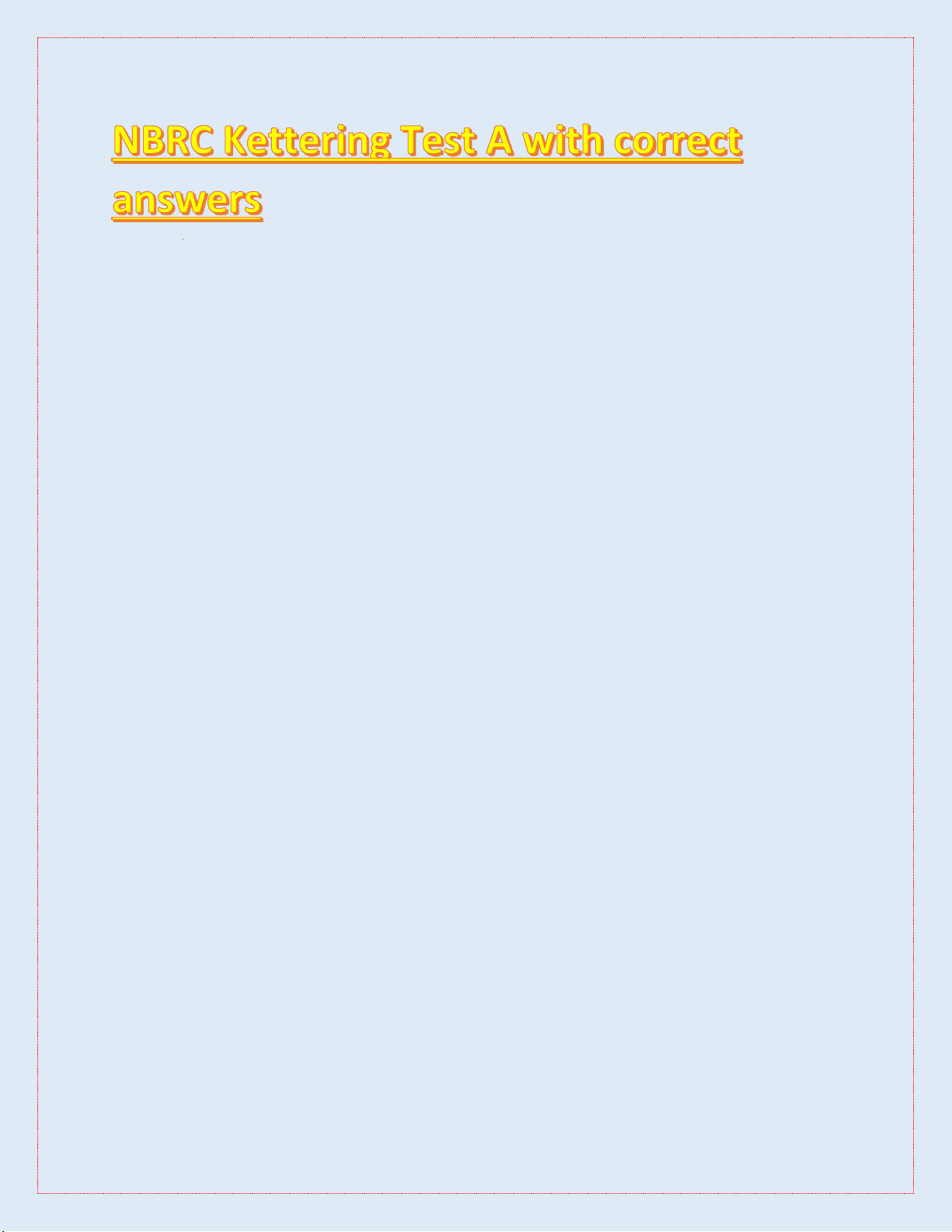
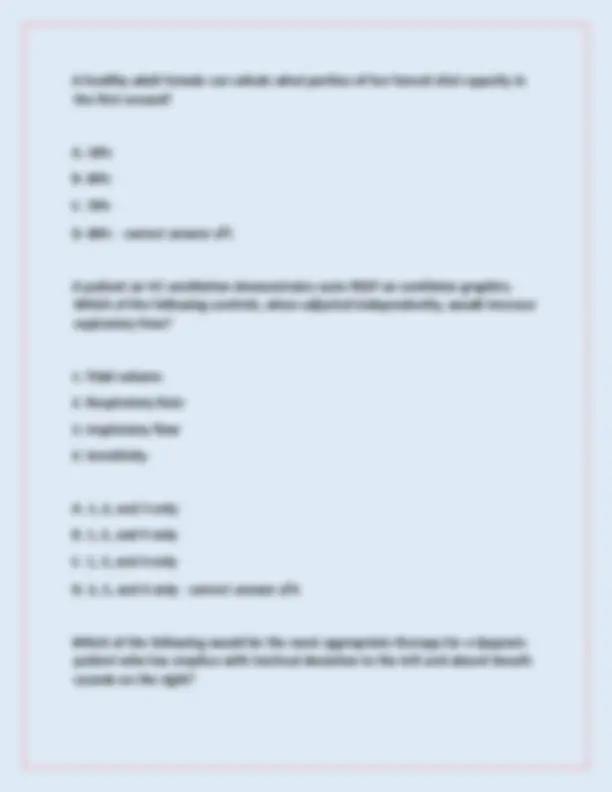
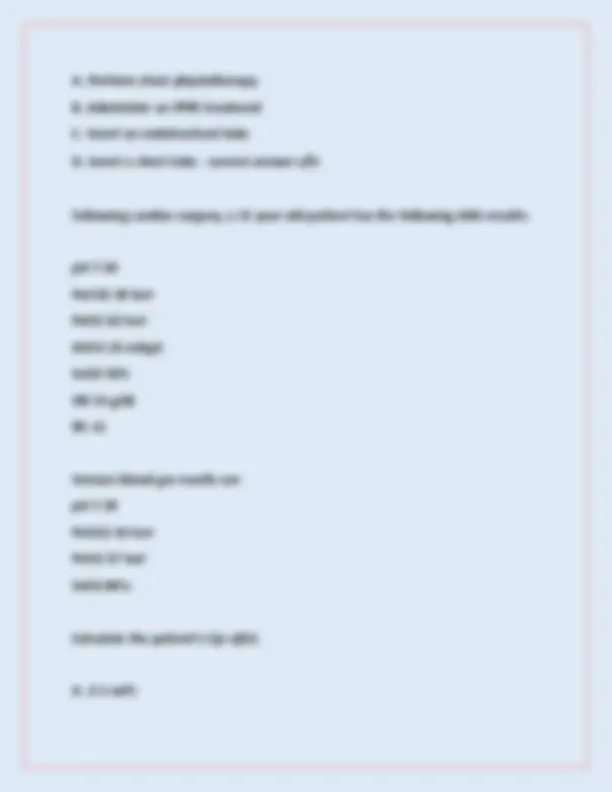
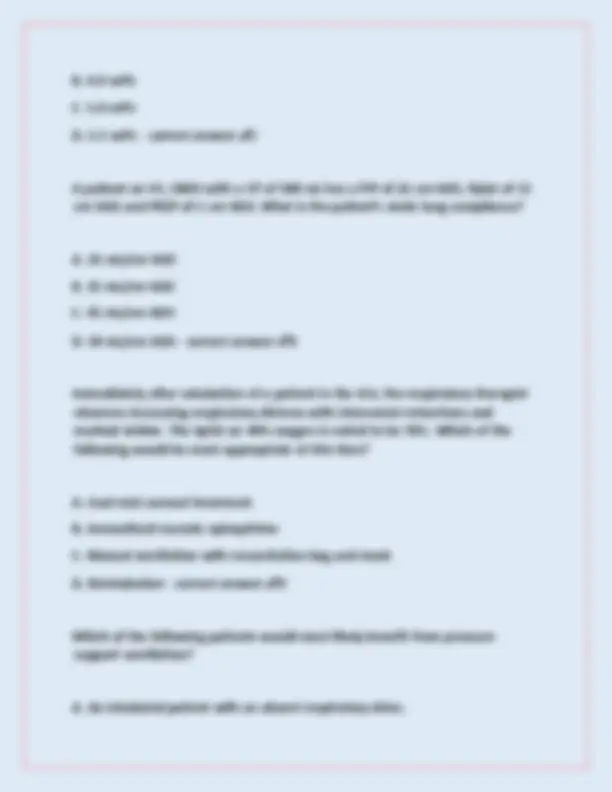
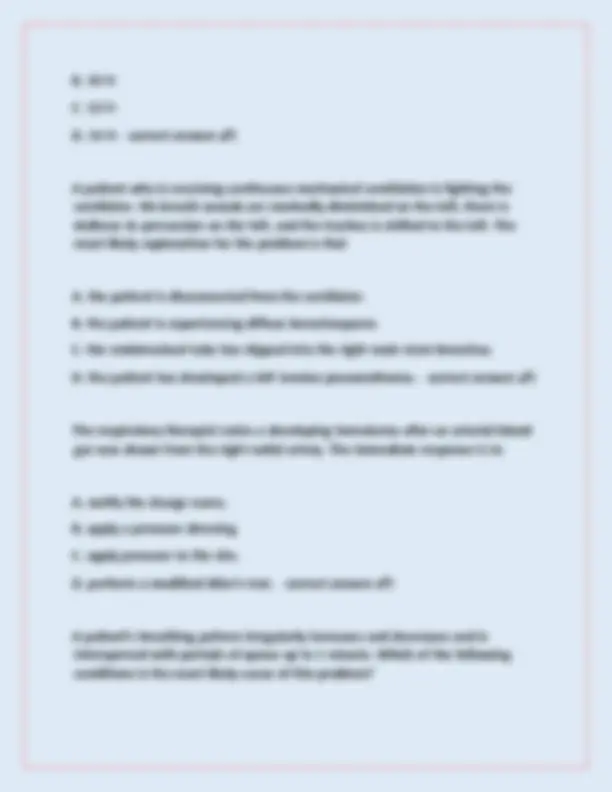
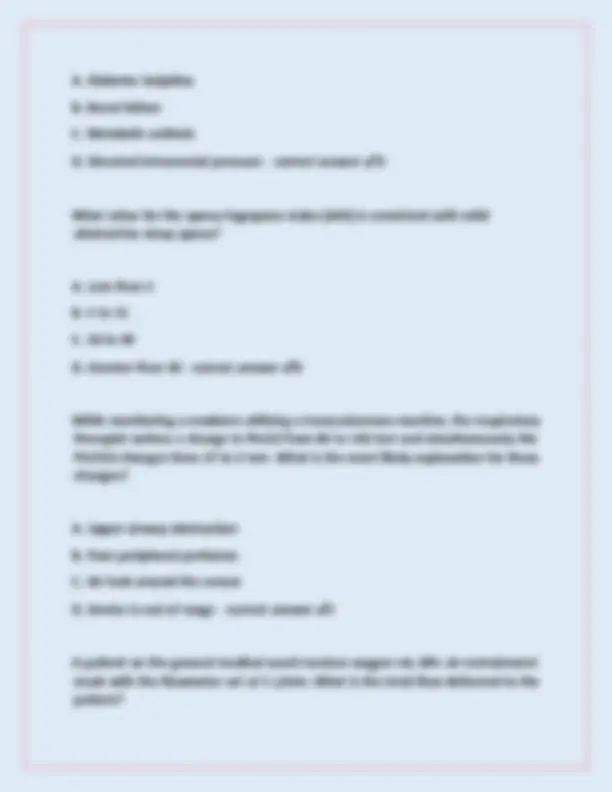
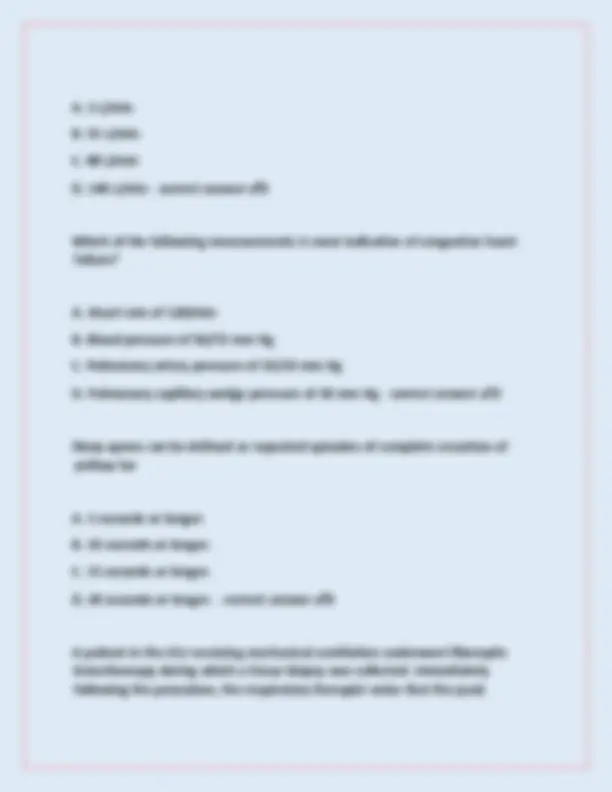
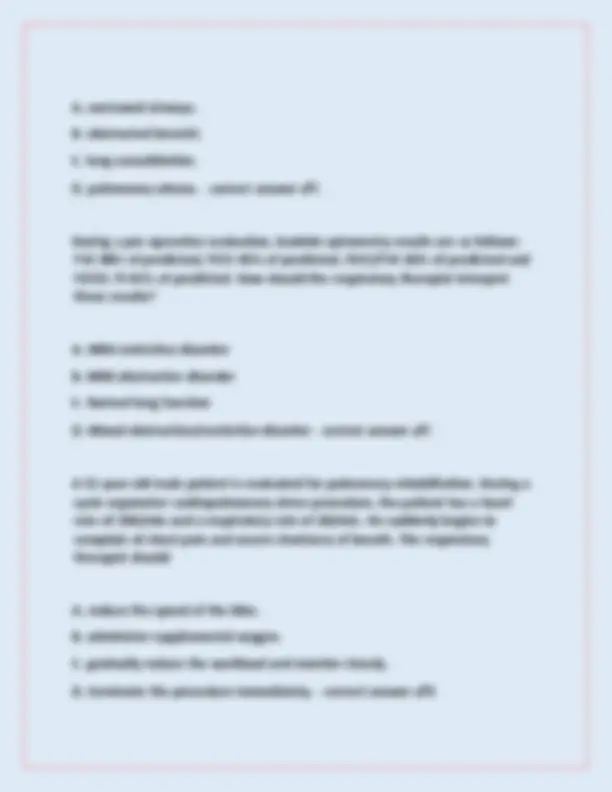
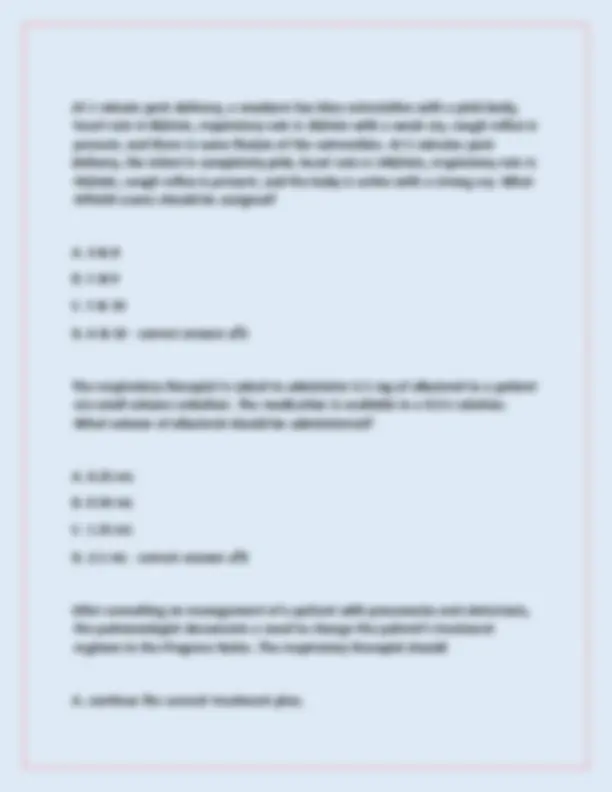
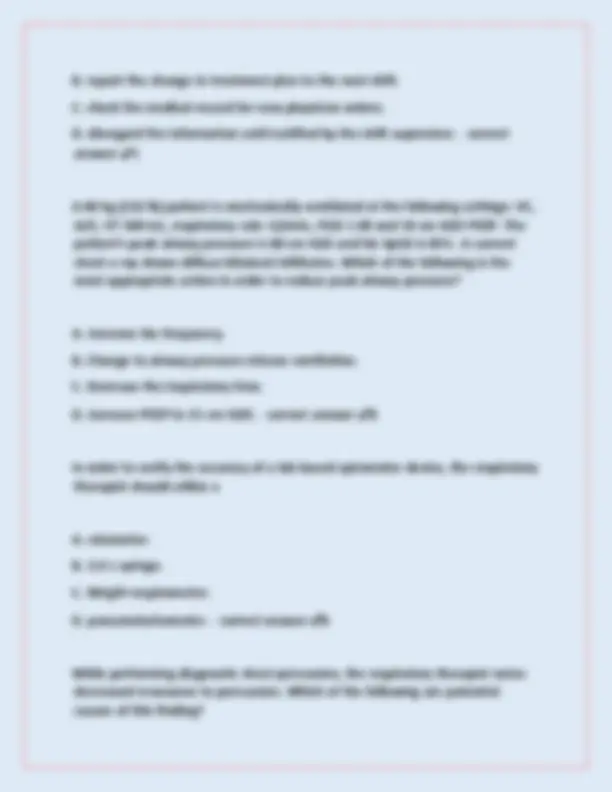
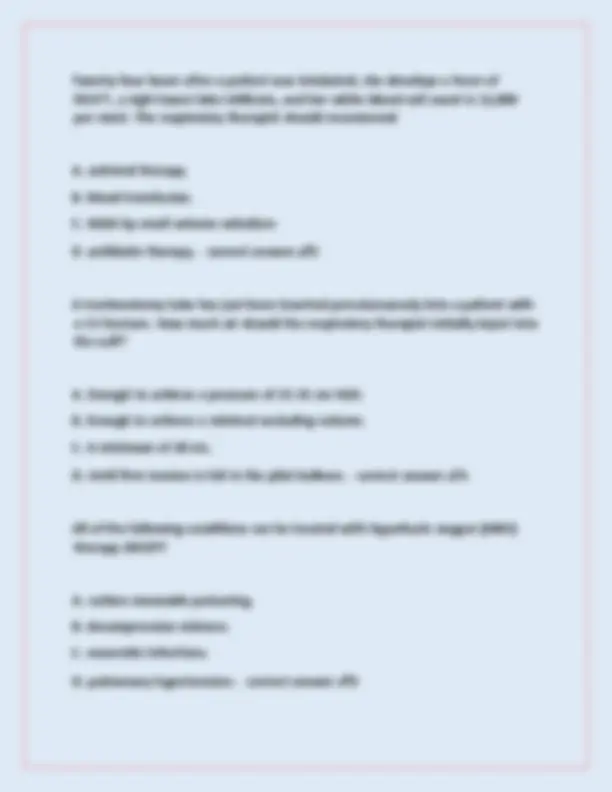
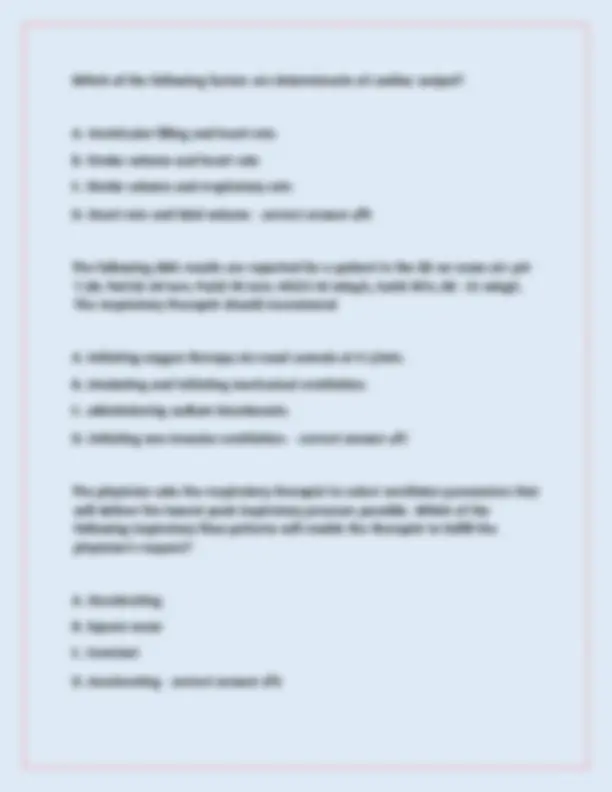
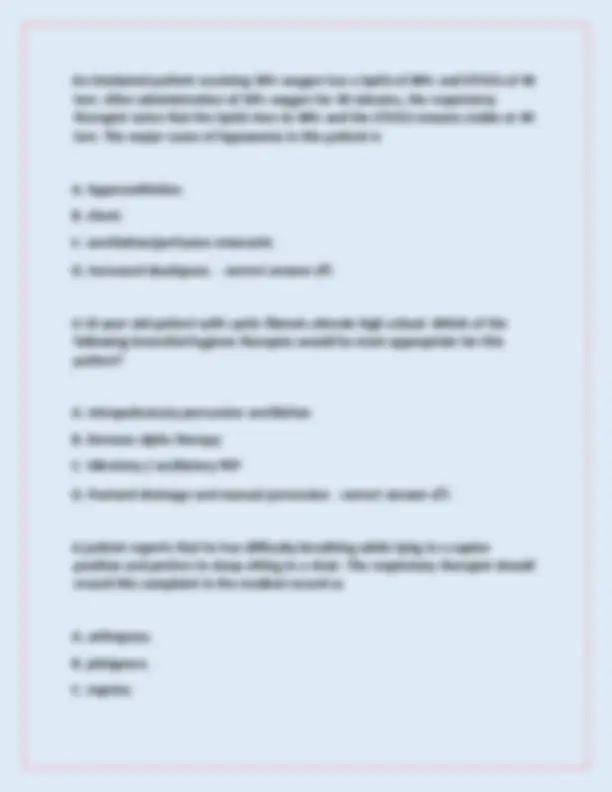
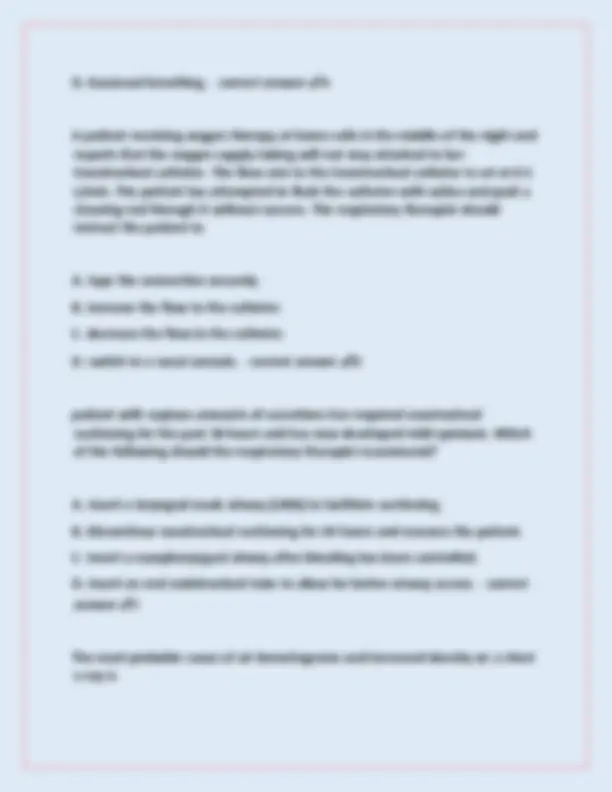
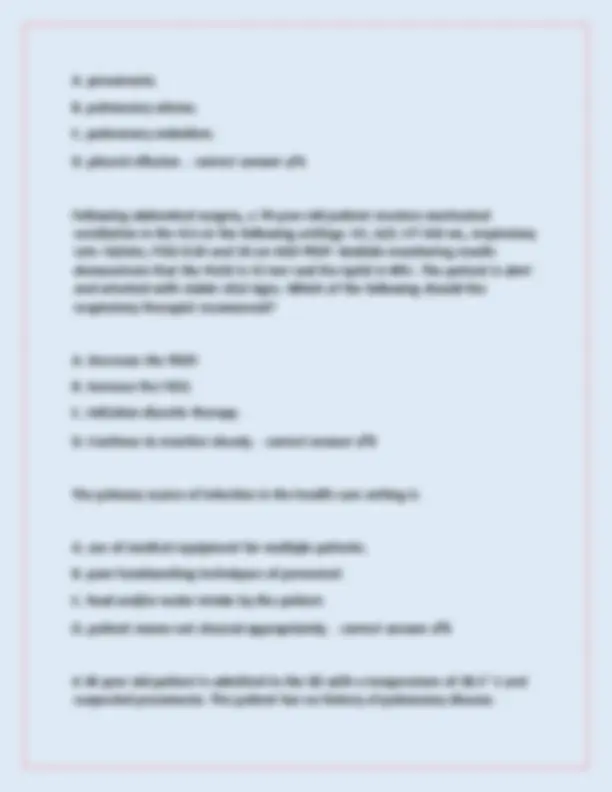
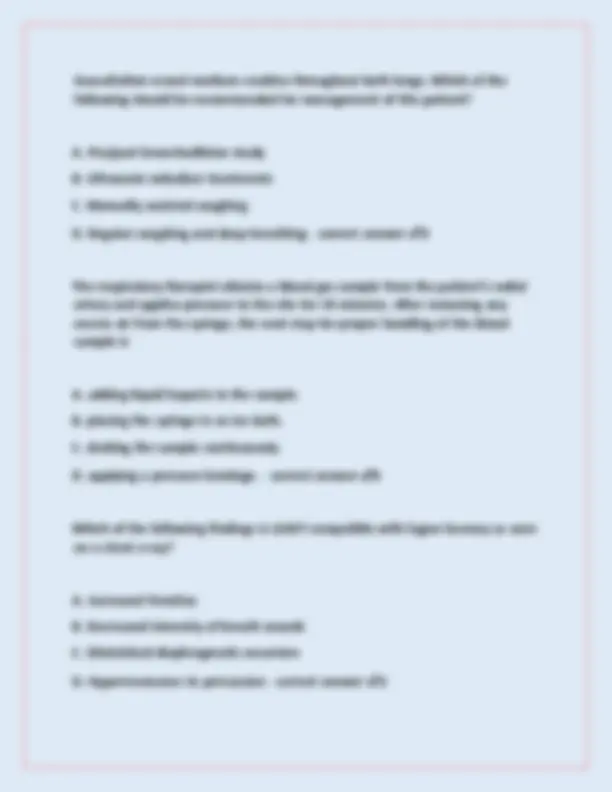
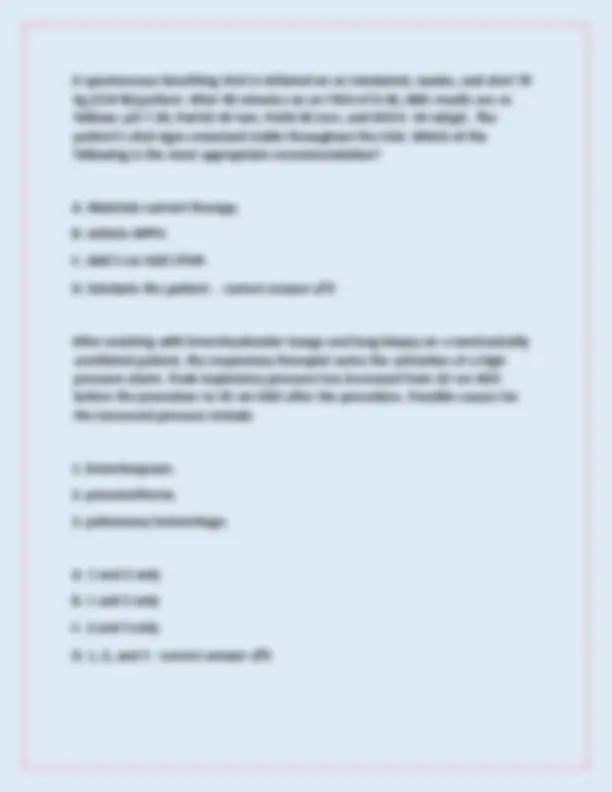
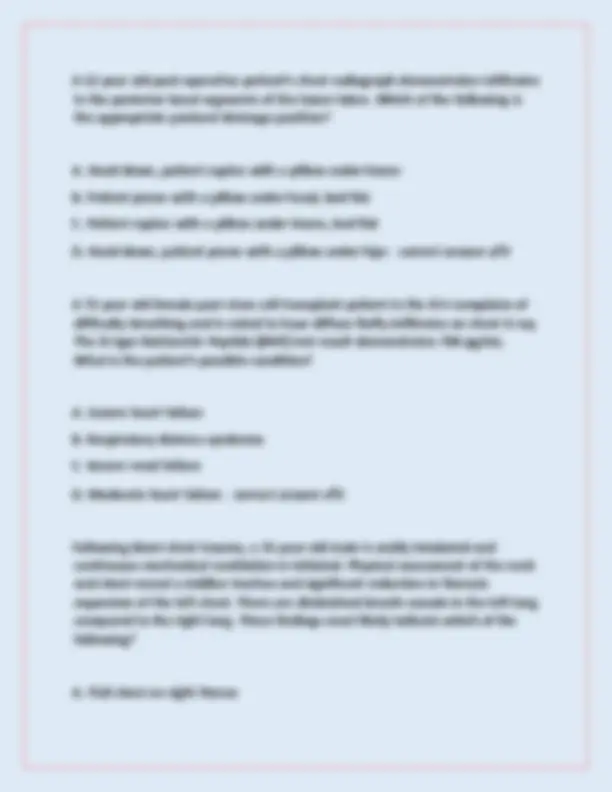
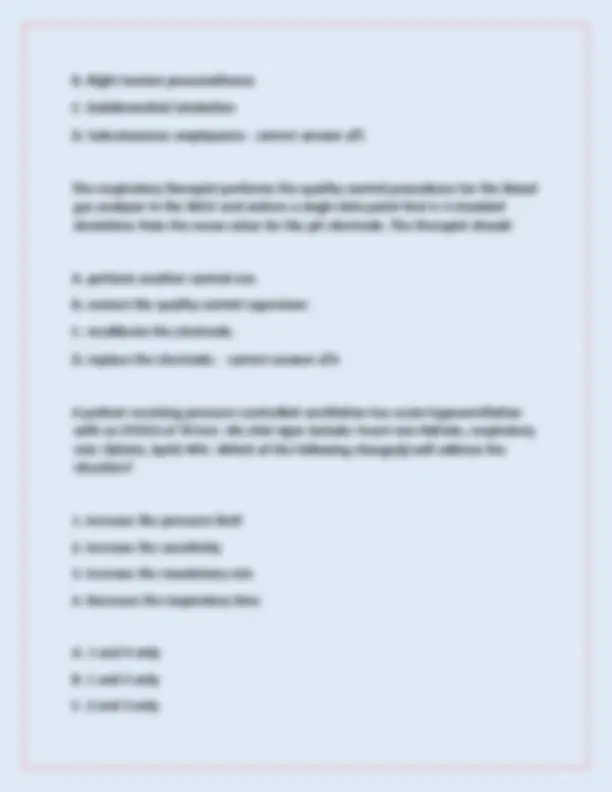
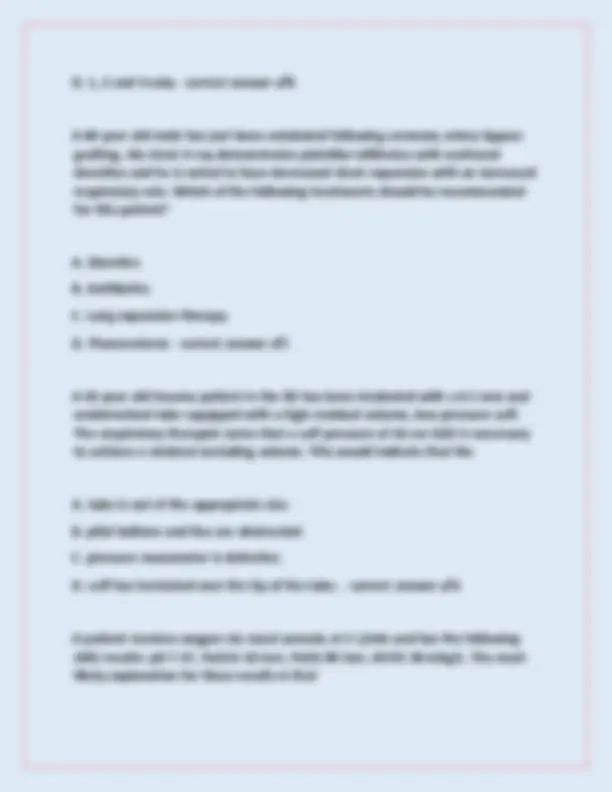
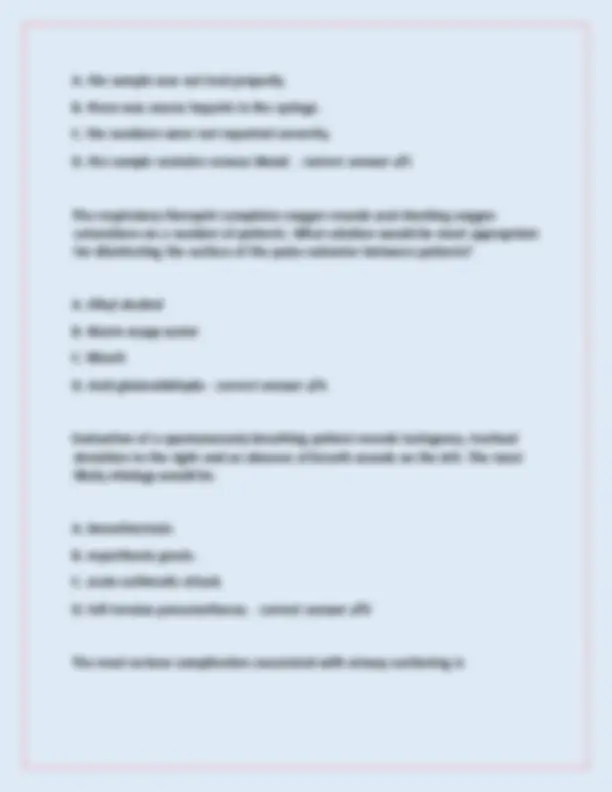
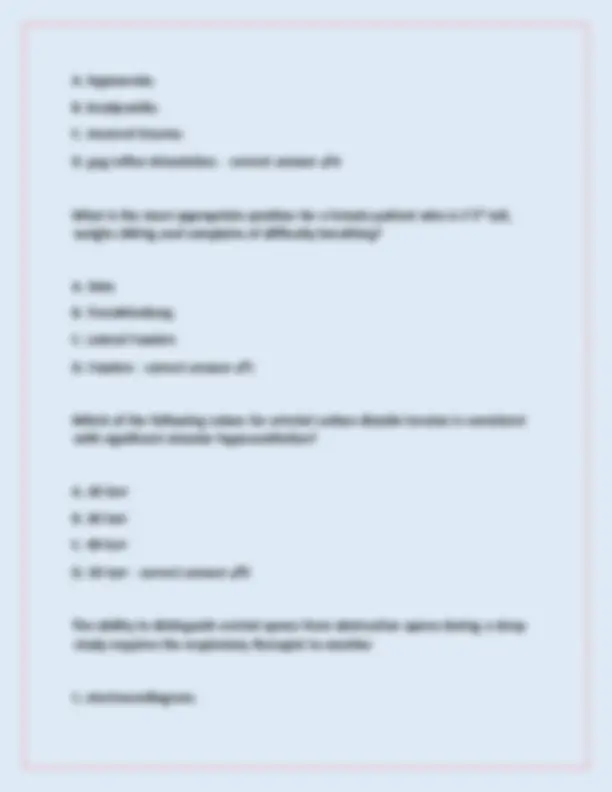
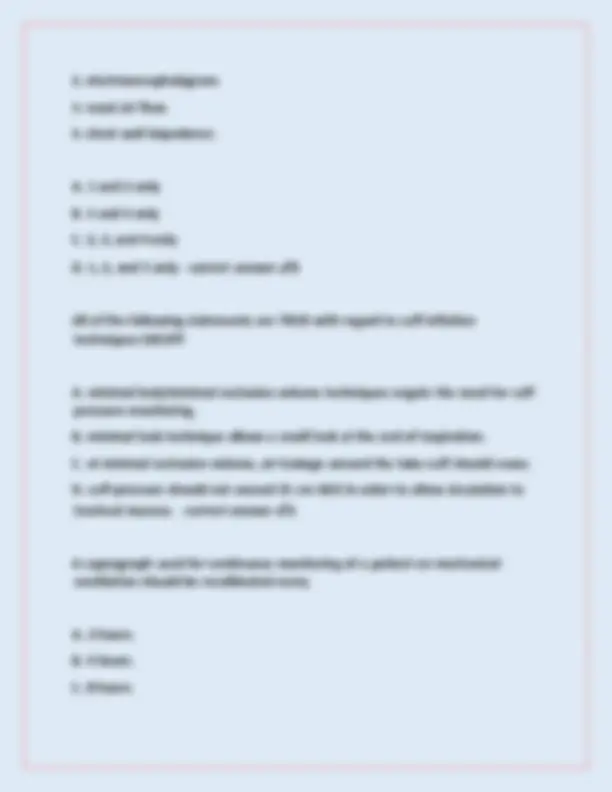
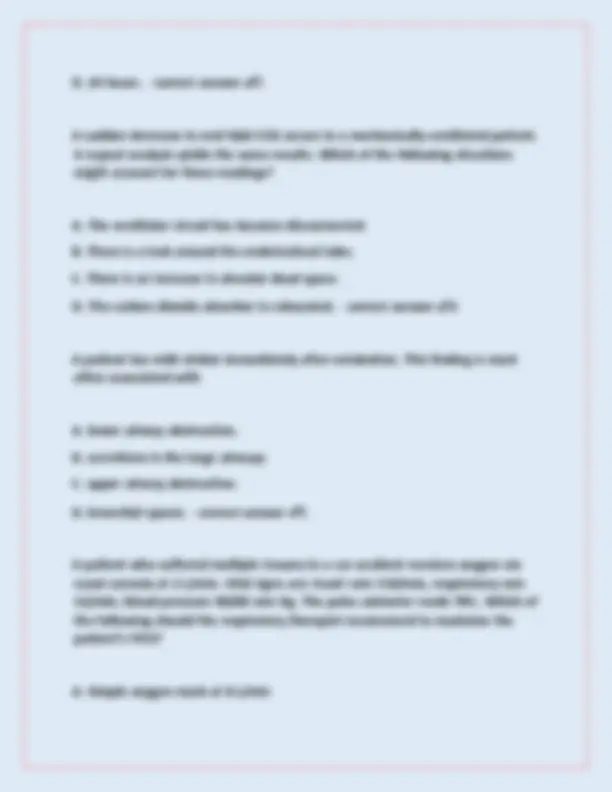

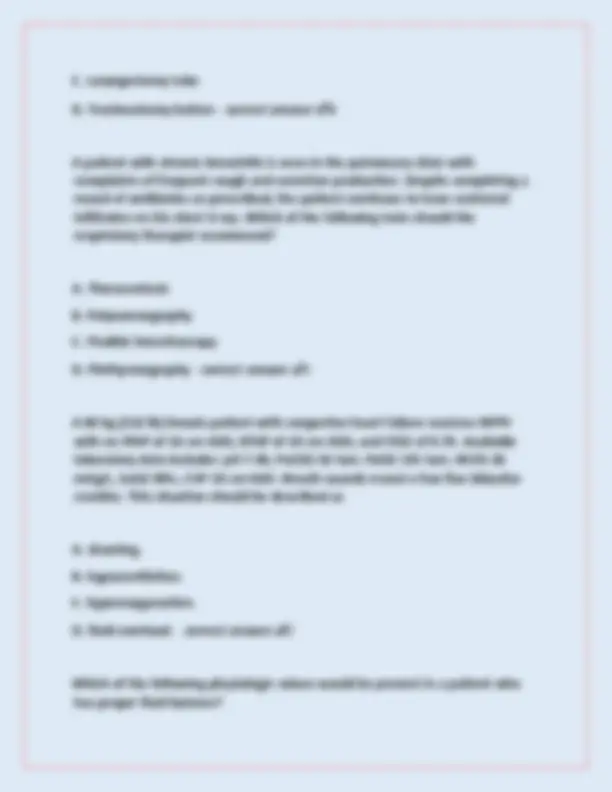
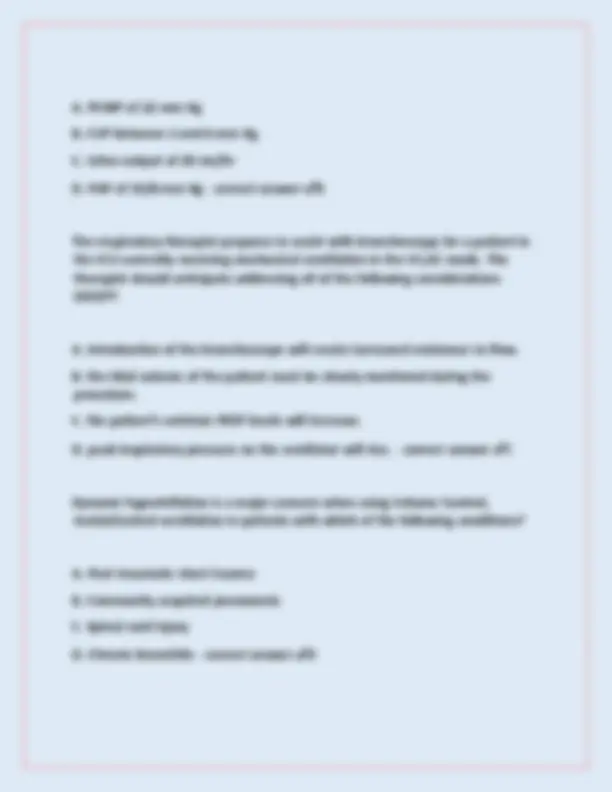
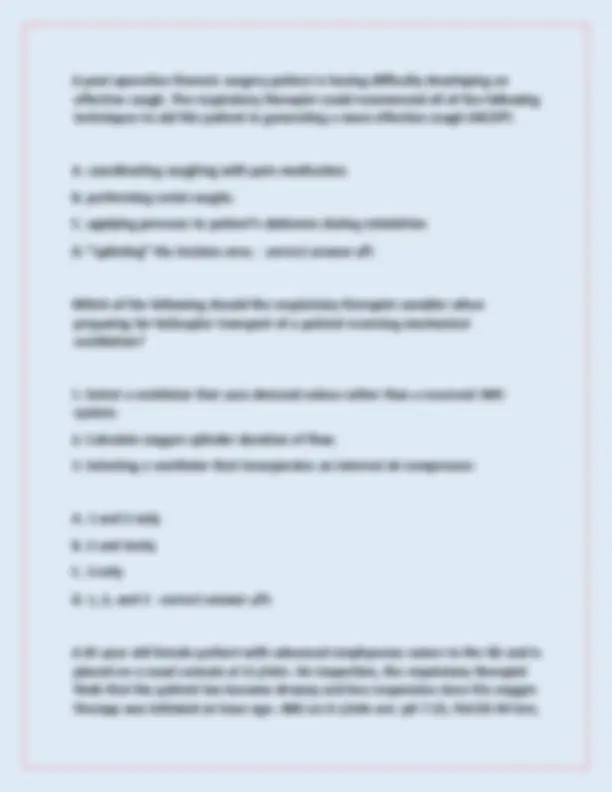
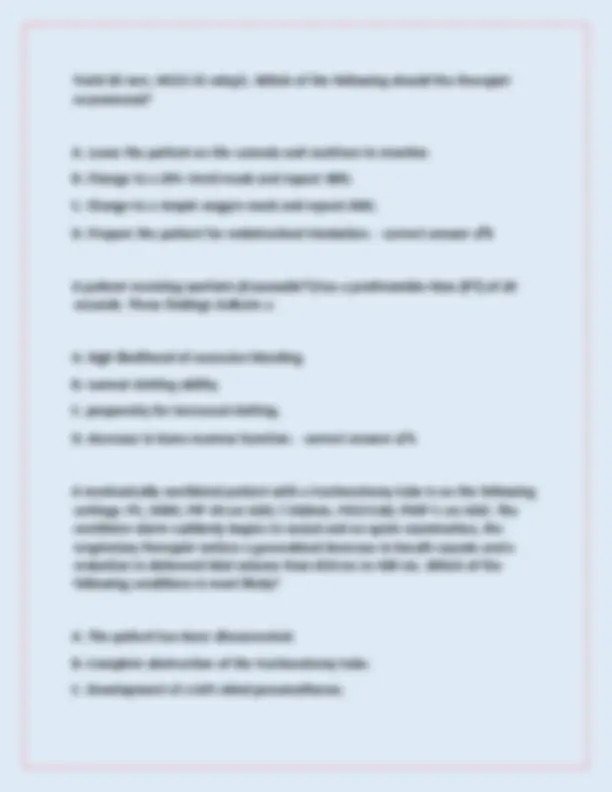
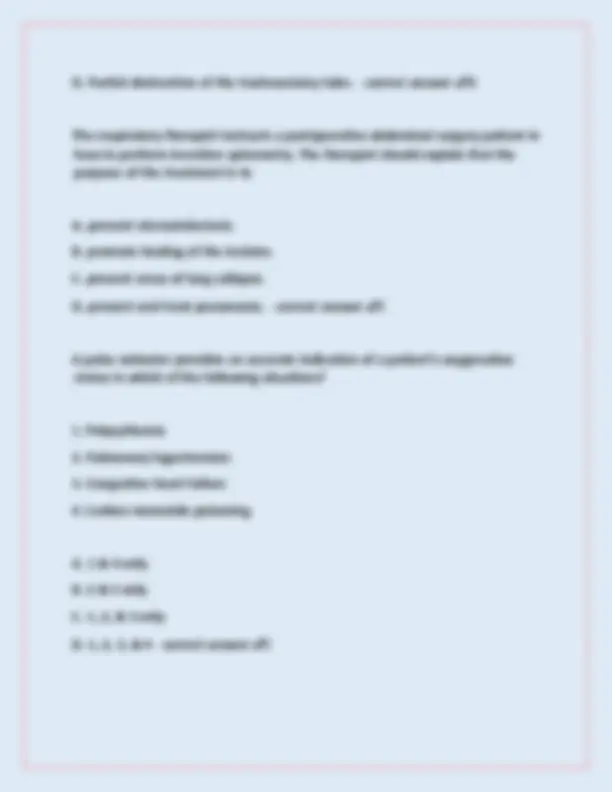
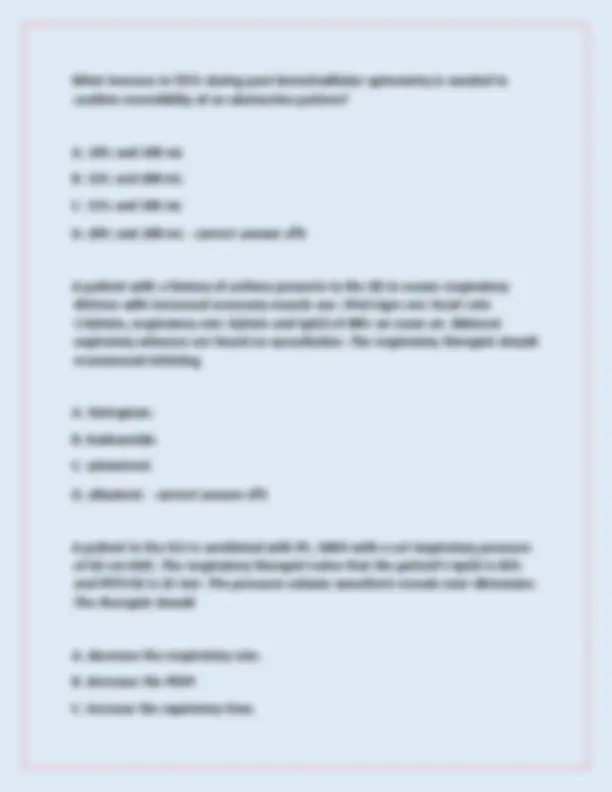
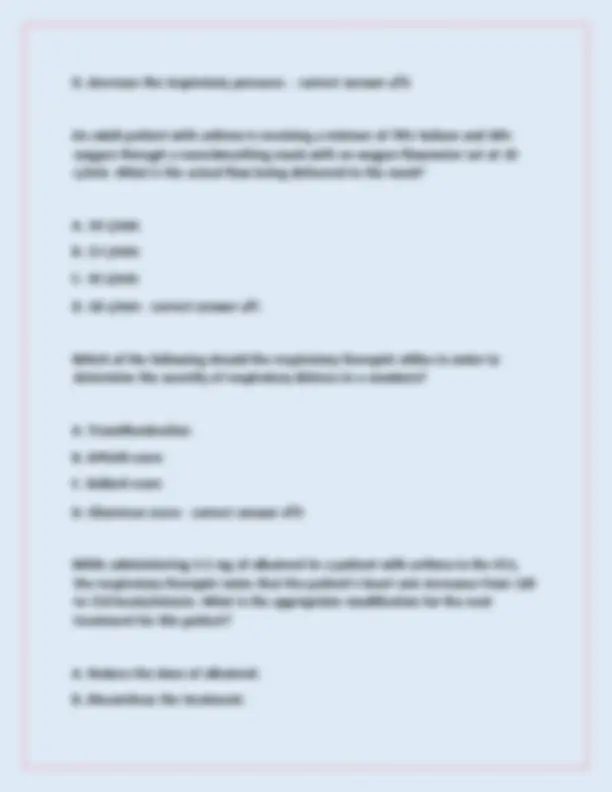
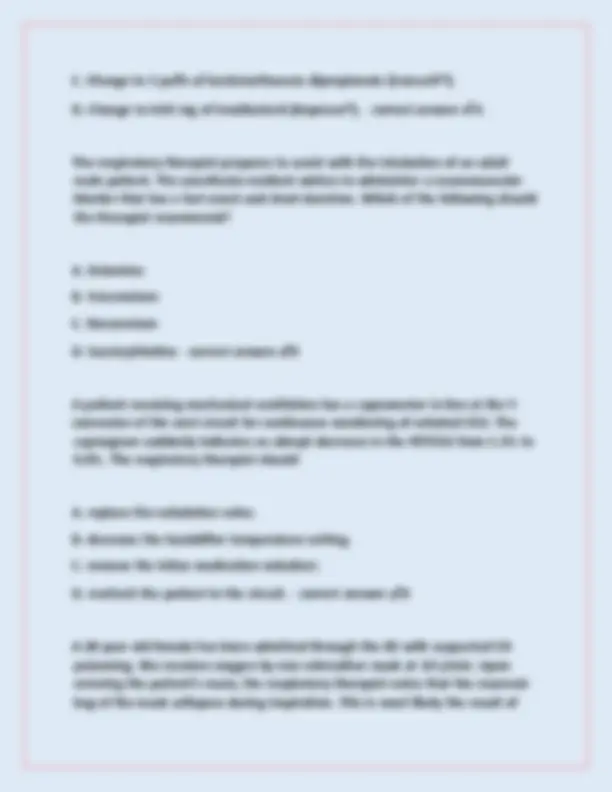
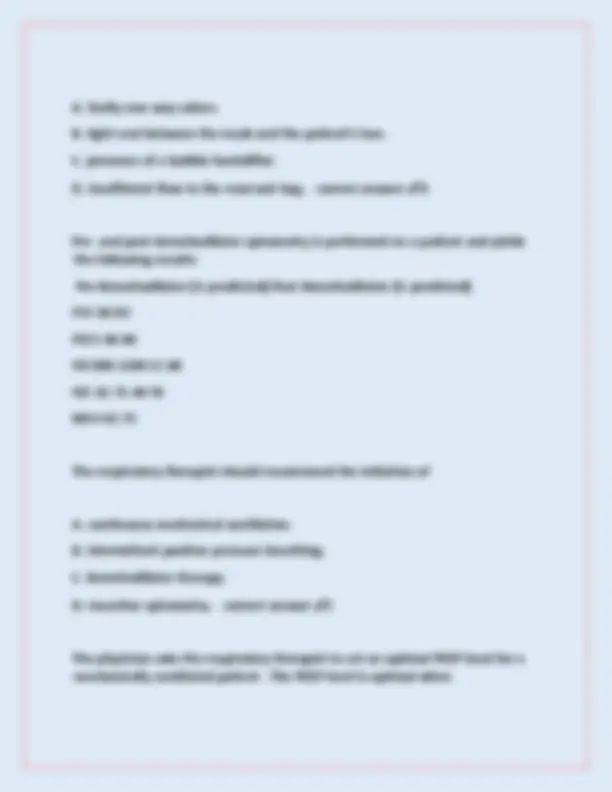

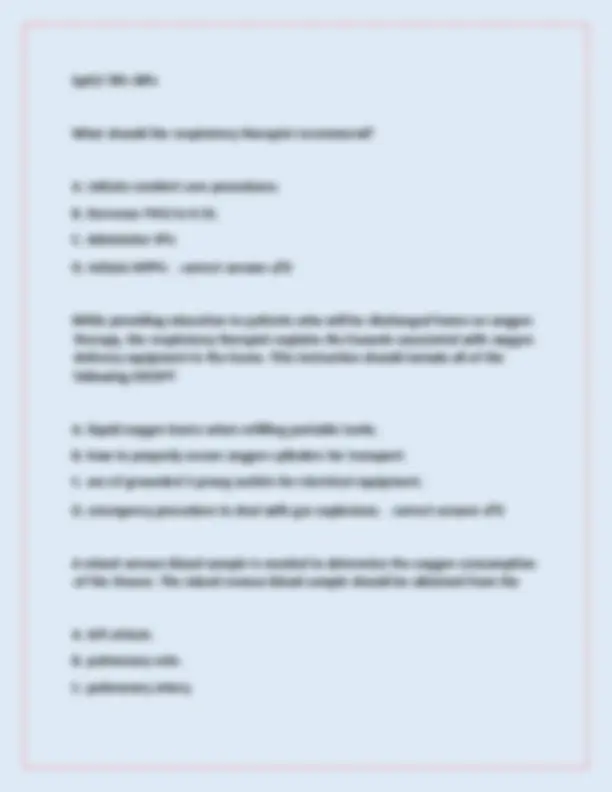
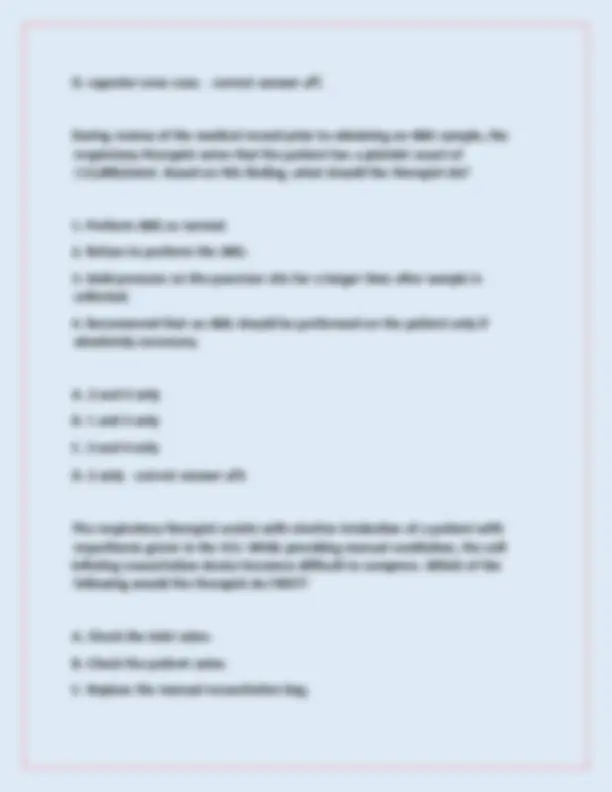
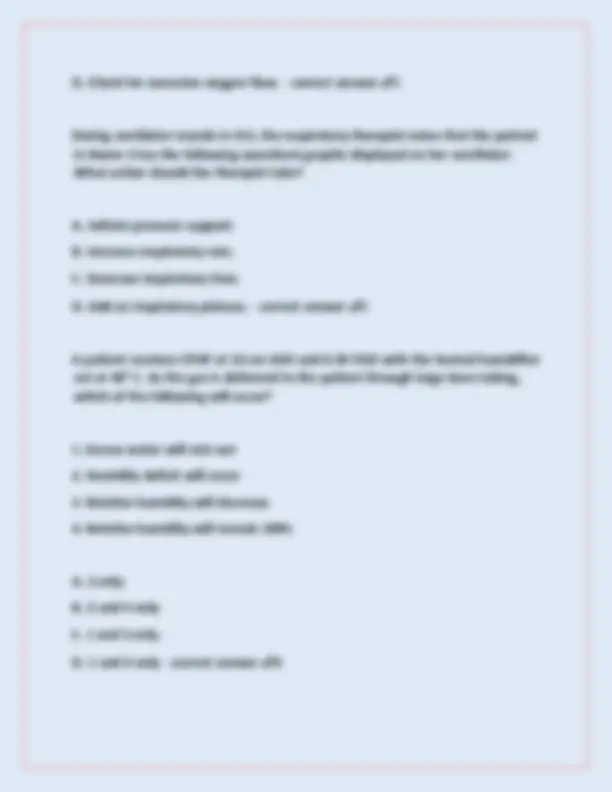
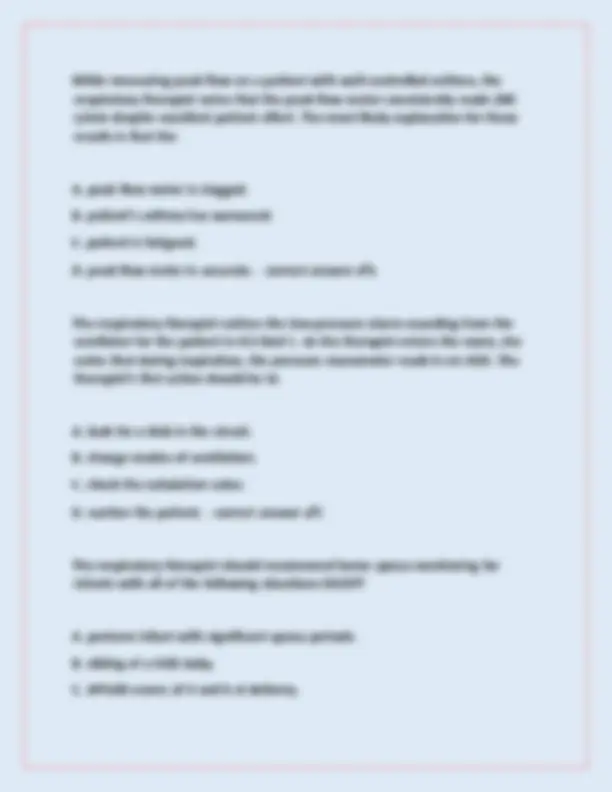
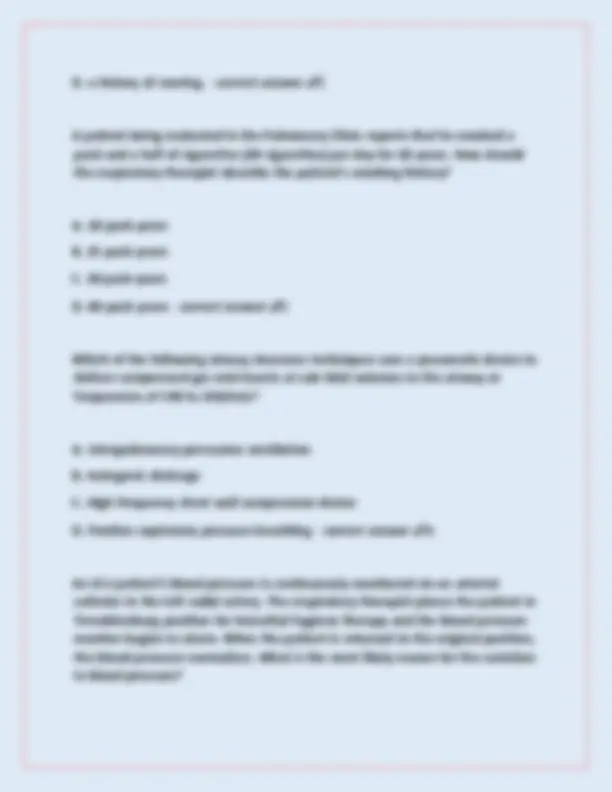
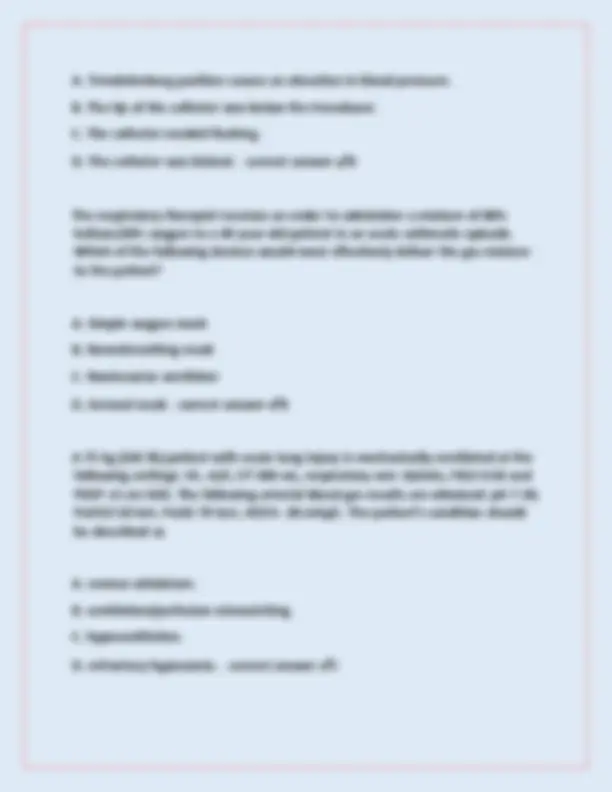
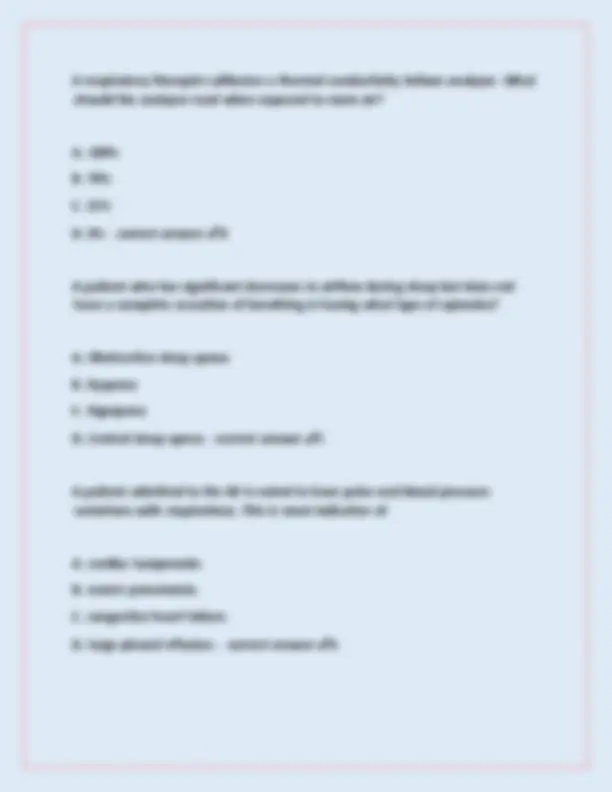
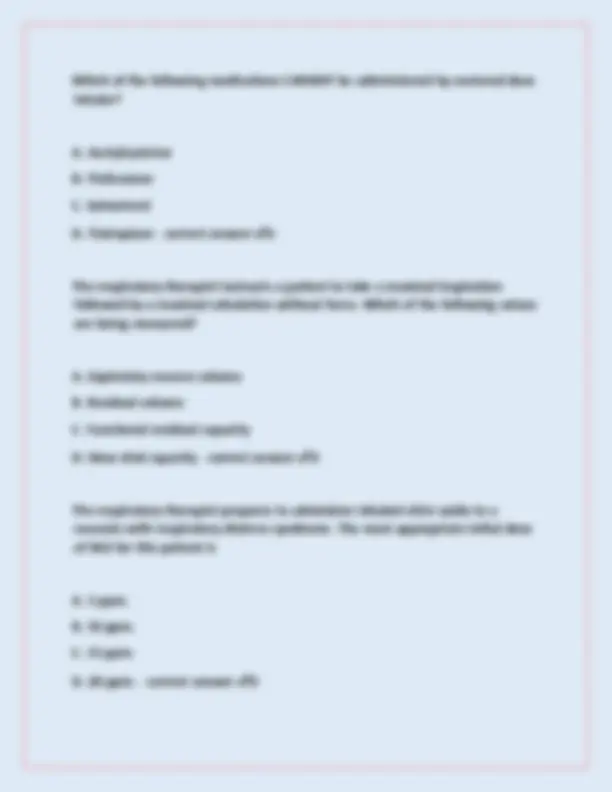
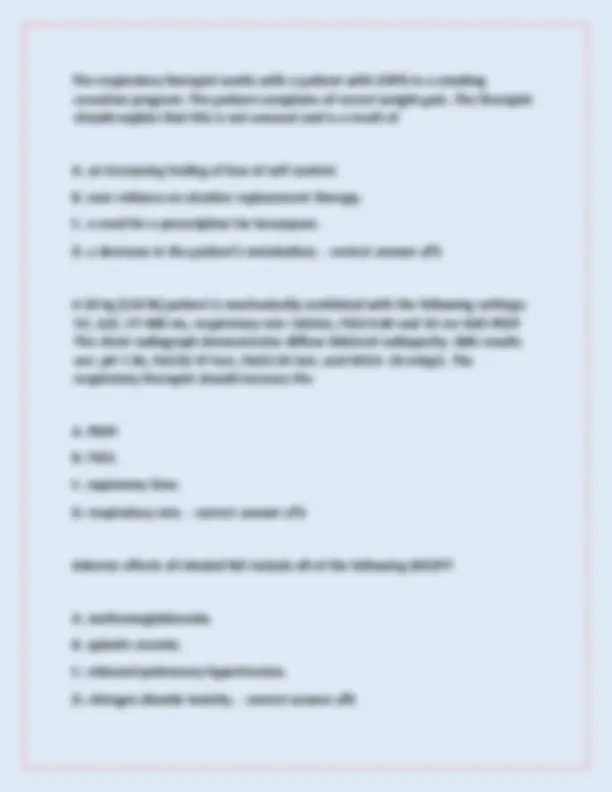
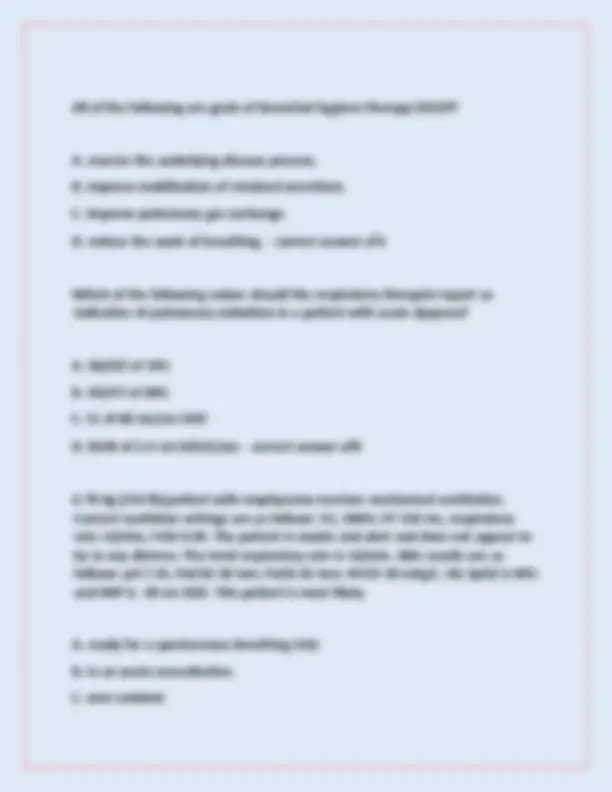
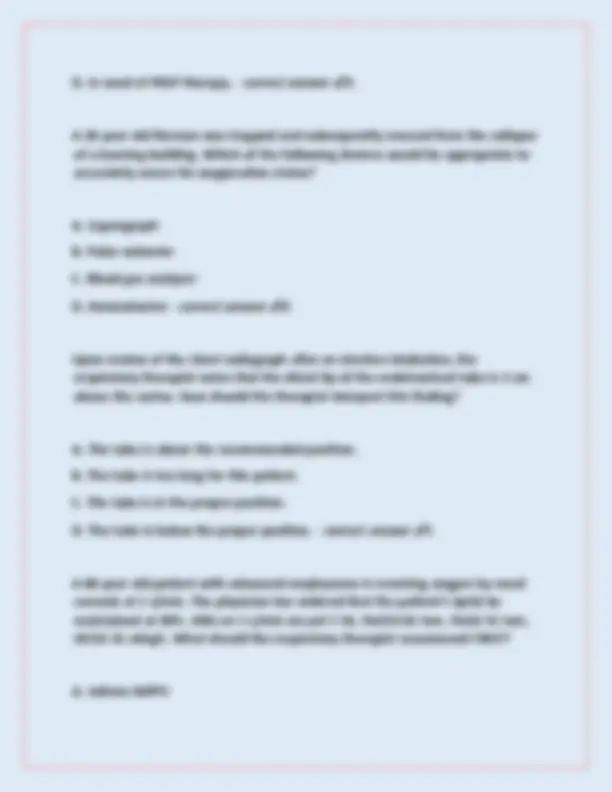
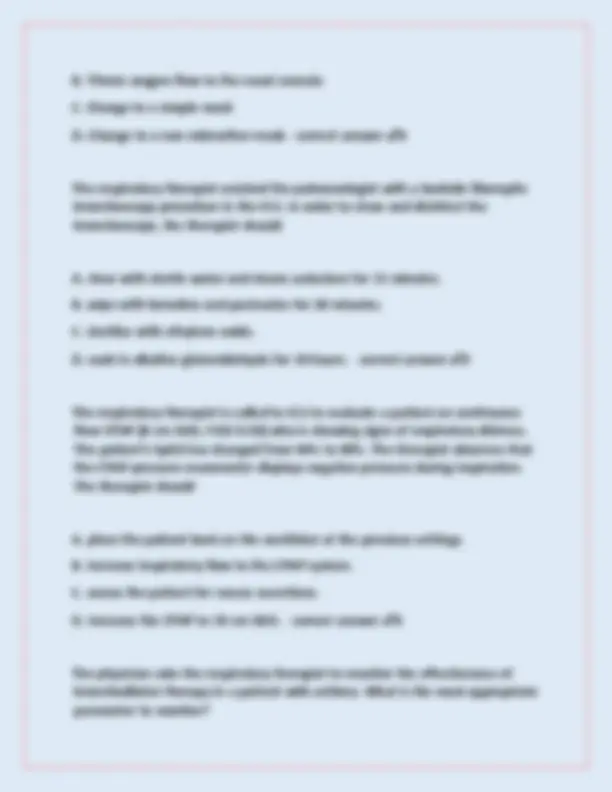
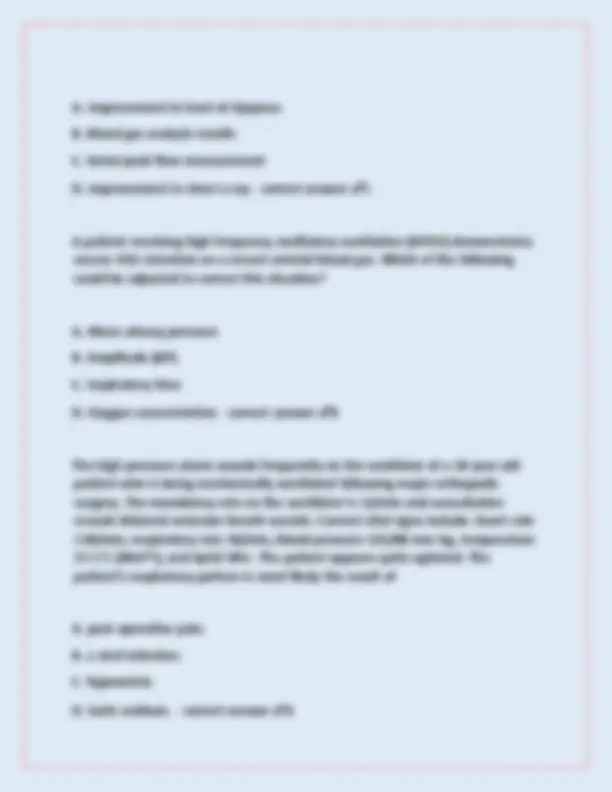
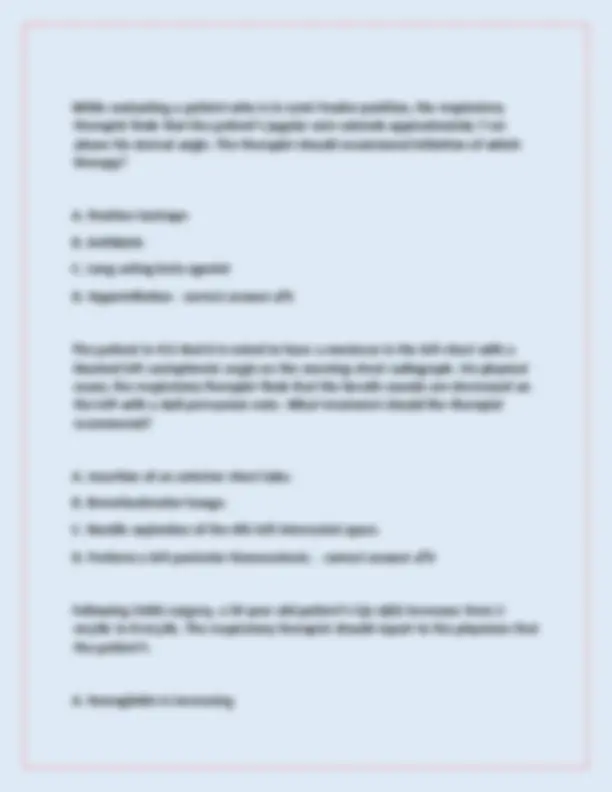
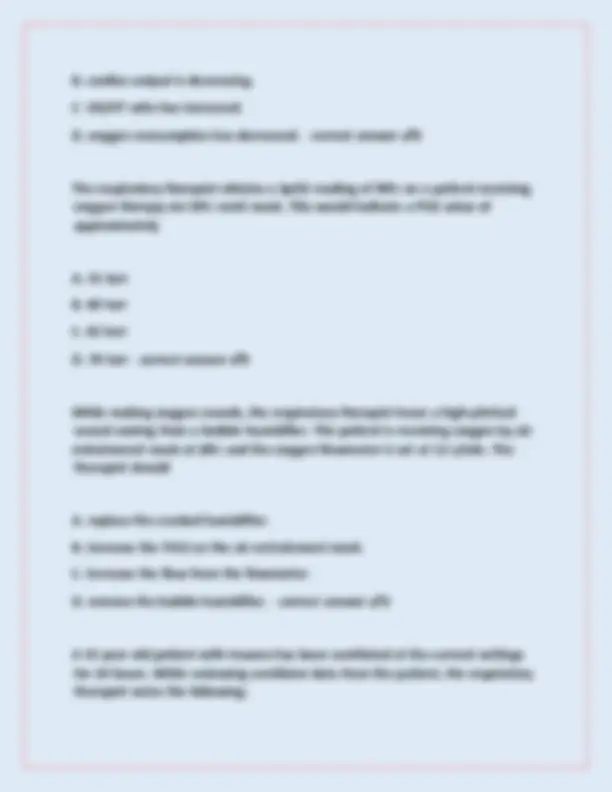
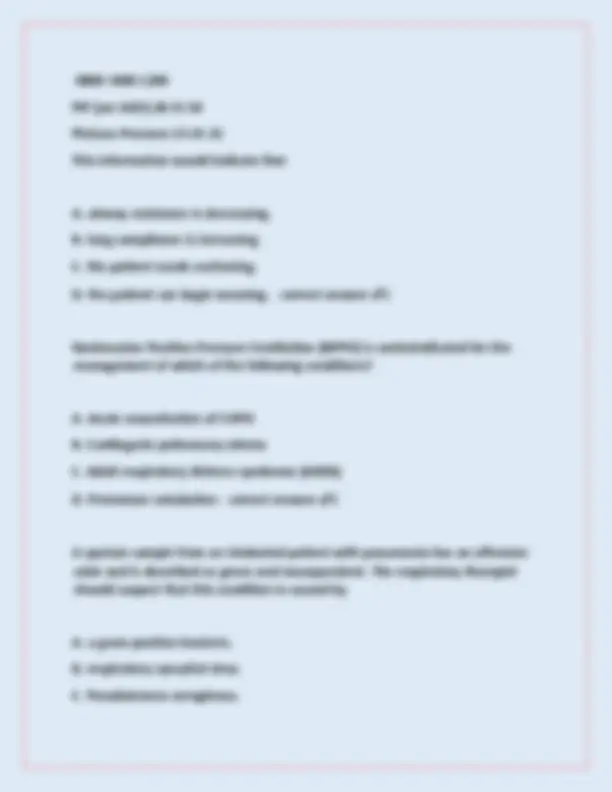
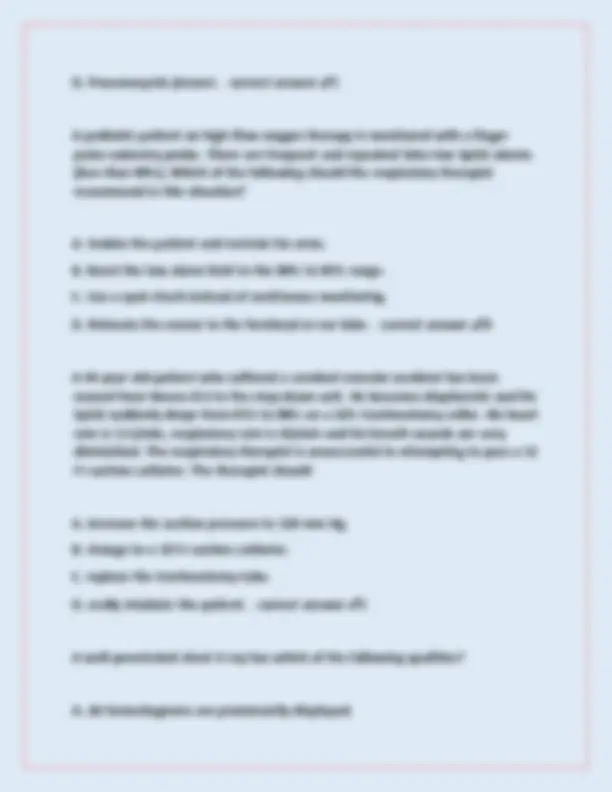
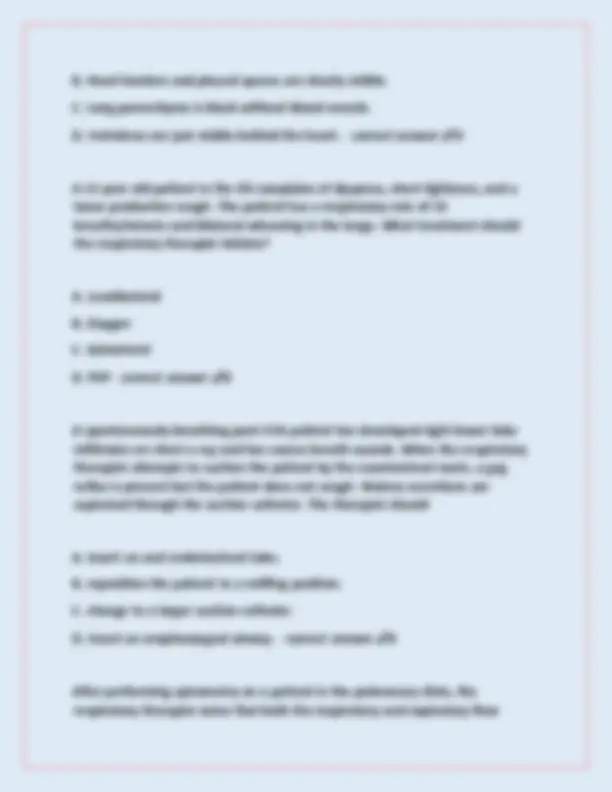
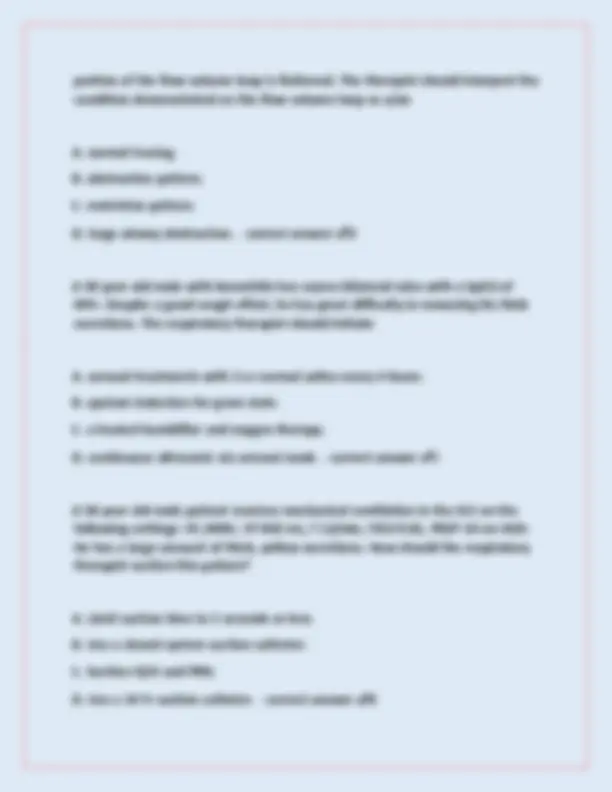
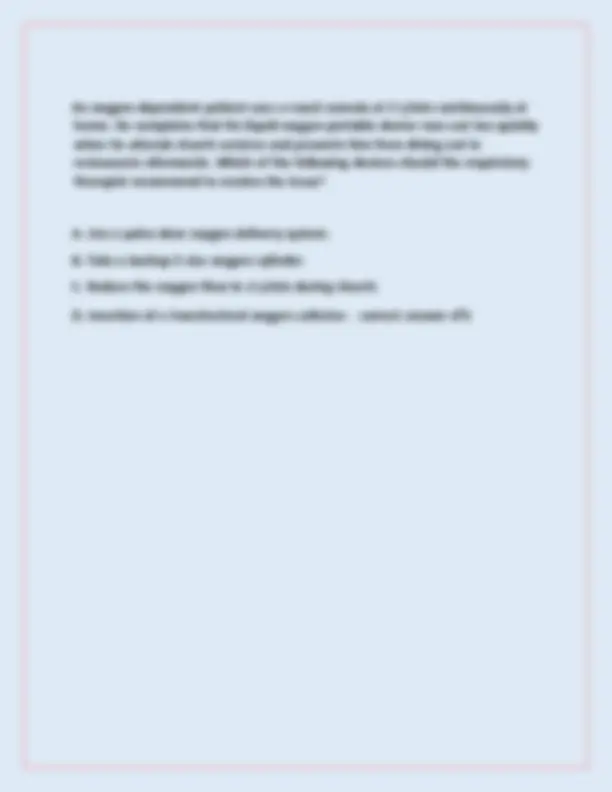


Study with the several resources on Docsity

Earn points by helping other students or get them with a premium plan


Prepare for your exams
Study with the several resources on Docsity

Earn points to download
Earn points by helping other students or get them with a premium plan
Community
Ask the community for help and clear up your study doubts
Discover the best universities in your country according to Docsity users
Free resources
Download our free guides on studying techniques, anxiety management strategies, and thesis advice from Docsity tutors
A series of multiple choice questions and answers related to respiratory therapy. It covers various aspects of respiratory care, including patient assessment, treatment modalities, and clinical scenarios. The questions are designed to test knowledge and understanding of respiratory therapy principles and practices.
Typology: Exams
1 / 62

This page cannot be seen from the preview
Don't miss anything!























































A | 48 |year-old |female |is |admitted |to |the |ED |with |diaphoresis, |jugular |venous |distension, |and |3+ |pitting |edema |in |the |ankles. |These |findings |are |consistent |with
A. |liver |failure.
B. |pulmonary |embolism.
C. |heart |failure.
D. |electrolyte |imbalance. |- |correct |answer |✔C
A |patient |is |admitted |to |the |ED |following |a |motor |vehicle |accident. |On |physical |exam, |the |respiratory |therapist |discovers |that |breath |sounds |are |absent |in |the |left |chest |with |a |hyper-resonant |percussion |note. |The |trachea |is |shifted |to |the |right. |The |patient's |heart |rate |is |45/min, |respiratory |rate |is |30/min, |and |blood |pressure |is |60/40 |mm |Hg. |What |action |should |the |therapist |recommend |first?
A. |Call |for |a |STAT |chest |x-ray.
B. |Insert |a |chest |tube |into |the |left |chest.
C. |Needle |aspirate |the |2nd |left |intercostal |space.
D. |Activate |the |medical |emergency |team |to |intubate |the |patient. |- |correct
|answer |✔C
All |of |the |following |strategies |are |likely |to |decrease |the |likelihood |of |damage |to |the |tracheal |mucosa |EXCEPT
A. |maintaining |cuff |pressures |between | 20 |and | 25 |mm |Hg.
B. |using |the |minimal |leak |technique |for |inflation.
C. |using |a |low-residual-volume, |low-compliance |cuff.
D. |monitoring |intracuff |pressures. |- |correct |answer |✔C
A | 52 |year-old |post-operative |cholecystectomy |patient's |breath |sounds |become |more |coarse |upon |completion |of |postural |drainage |with |percussion. |The |respiratory |therapist |should |recommend
A. |continuing |the |therapy |until |breath |sounds |improve.
B. |administering |dornase |alpha.
C. |administering |albuterol |therapy.
D. |deep |breathing |and |coughing |to |clear |secretions. |- |correct |answer |✔D
A | 65 |kg |spinal |cord |injured |patient |develops |atelectasis. |His |inspiratory |capacity |is |30% |of |his |predicted |value. |What |bronchial |hygiene |therapy |would |be |most |appropriate |initially?
A. |Incentive |spirometry
B. |IPPB
C. |Postural |drainage |and |percussion
D. |PEP |therapy |- |correct |answer |✔B
A. |Perform |chest |physiotherapy
B. |Administer |an |IPPB |treatment
C. |Insert |an |endotracheal |tube
D. |Insert |a |chest |tube |- |correct |answer |✔D
Following |cardiac |surgery, |a | 55 |year-old |patient |has |the |following |ABG |results: |
pH |7.
PaCO2 | 30 |torr
PaO2 | 62 |torr
HCO3 | 25 |mEq/L
SaO2 |92%
HB | 14 |g/dL
BE |+2. |
Venous |blood |gas |results |are
pH |7.
PvCO2 | 43 |torr
PvO2 | 37 |torr
SvO2 |66%. |
Calculate |the |patient's |C(a-v)O2.
A. |2.5 |vol%
B. |4.0 |vol%
C. |5.0 |vol%
D. |5.5 |vol% |- |correct |answer |✔C
A |patient |on |VC, |SIMV |with |a |VT |of | 500 |mL |has |a |PIP |of | 25 |cm |H2O, |Pplat |of | 15 |cm |H2O |and |PEEP |of | 5 |cm |H2O. |What |is |the |patient's |static |lung |compliance?
A. | 25 |mL/cm |H2O
B. | 35 |mL/cm |H2O
C. | 45 |mL/cm |H2O
D. | 50 |mL/cm |H2O |- |correct |answer |✔D
Immediately |after |extubation |of |a |patient |in |the |ICU, |the |respiratory |therapist |observes |increasing |respiratory |distress |with |intercostal |retractions |and |marked |stridor. |The |SpO2 |on |40% |oxygen |is |noted |to |be |76%. |Which |of |the |following |would |be |most |appropriate |at |this |time?
A. |Cool |mist |aerosol |treatment
B. |Aerosolized |racemic |epinephrine
C. |Manual |ventilation |with |resuscitation |bag |and |mask
D. |Reintubation |- |correct |answer |✔D
Which |of |the |following |patients |would |most |likely |benefit |from |pressure |support |ventilation?
A. |An |intubated |patient |with |an |absent |respiratory |drive.
D. | 3 |and | 4 |only |- |correct |answer |✔A
The |respiratory |therapist |provides |education |for |a |patient |who |is |being |discharged |home |on |aerosol |therapy. |The |most |important |reason |for |the |patient |to |follow |the |recommended |cleaning |procedures |using |a |vinegar/water |solution |is |that |this |solution |will
A. |sterilize |the |equipment.
B. |retard |bacterial |growth.
C. |kill |all |micro-organisms |and |spores.
D. |extend |the |equipment |life. |- |correct |answer |✔B
A |patient |who |complains |of |dyspnea |is |noted |to |have |a |dry, |non-productive |cough. |On |physical |examination, |breath |sounds |are |diminished |on |the |right, |tactile |fremitus |is |decreased |and |there |is |dullness |to |percussion |over |the |right |lower |lobe. |The |respiratory |therapist |should |suspect |that |the |patient |is |suffering |from
A. |pneumonia.
B. |pulmonary |embolism.
C. |pleural |effusion.
D. |bronchiolitis. |- |correct |answer |✔C
Which |of |the |following |suction |catheters |would |be |appropriate |to |use |for |a |patient |with |a |size |8.0 |mm |ID |endotracheal |tube?
A. | 8 |Fr
B. | 10 |Fr
C. | 12 |Fr
D. | 14 |Fr |- |correct |answer |✔C
A |patient |who |is |receiving |continuous |mechanical |ventilation |is |fighting |the |ventilator. |His |breath |sounds |are |markedly |diminished |on |the |left, |there |is |dullness |to |percussion |on |the |left, |and |the |trachea |is |shifted |to |the |left. |The |most |likely |explanation |for |the |problem |is |that
A. |the |patient |is |disconnected |from |the |ventilator.
B. |the |patient |is |experiencing |diffuse |bronchospasm.
C. |the |endotracheal |tube |has |slipped |into |the |right |main |stem |bronchus.
D. |the |patient |has |developed |a |left |tension |pneumothorax. |- |correct |answer |✔C
The |respiratory |therapist |notes |a |developing |hematoma |after |an |arterial |blood |gas |was |drawn |from |the |right |radial |artery. |The |immediate |response |is |to
A. |notify |the |charge |nurse.
B. |apply |a |pressure |dressing.
C. |apply |pressure |to |the |site.
D. |perform |a |modified |Allen's |test. |- |correct |answer |✔C
A |patient's |breathing |pattern |irregularly |increases |and |decreases |and |is |interspersed |with |periods |of |apnea |up |to | 1 |minute. |Which |of |the |following |conditions |is |the |most |likely |cause |of |this |problem?
A. | 5 |L/min
B. | 55 |L/min
C. | 88 |L/min
D. | 140 |L/min |- |correct |answer |✔B
Which |of |the |following |measurements |is |most |indicative |of |congestive |heart |failure?
A. |Heart |rate |of |120/min
B. |Blood |pressure |of |92/72 |mm |Hg
C. |Pulmonary |artery |pressure |of |25/10 |mm |Hg
D. |Pulmonary |capillary |wedge |pressure |of | 30 |mm |Hg |- |correct |answer |✔D
Sleep |apnea |can |be |defined |as |repeated |episodes |of |complete |cessation |of |airflow |for
A. | 5 |seconds |or |longer.
B. | 10 |seconds |or |longer.
C. | 15 |seconds |or |longer.
D. | 20 |seconds |or |longer. |- |correct |answer |✔B
A |patient |in |the |ICU |receiving |mechanical |ventilation |underwent |fiberoptic |bronchoscopy |during |which |a |tissue |biopsy |was |collected. |Immediately |following |the |procedure, |the |respiratory |therapist |notes |that |the |peak
|inspiratory |pressure |on |the |ventilator |has |increased. |Potential |causes |for |this |include |all |of |the |following |EXCEPT
A. |hypoxemia.
B. |pneumothorax.
C. |pulmonary |hemorrhage.
D. |bronchospasm/laryngospasm. |- |correct |answer |✔A
What |size |endotracheal |tube |would |be |appropriate |for |an |adult |female |patient?
A. |6.0 |to |6.5 |mm
B. |6.5 |to |7.0 |mm
C. |7.0 |to |7.5 |mm
D. |7.5 |to |8.0 |mm |- |correct |answer |✔C
The |respiratory |therapist |is |asked |to |evaluate |the |presence |of |Auto-PEEP |on |a |patient |receiving |mechanical |ventilation. |In |order |to |do |this, |the |therapist |should
A. |initiate |an |inspiratory |hold |just |after |the |next |ventilator-delivered |breath.
B. |initiate |an |expiratory |hold |just |prior |to |the |next |ventilator-delivered |breath.
C. |subtract |Pplat |from |Pdyn.
D. |subtract |set |PEEP |from |the |measured |Pplat. |- |correct |answer |✔B
A. |narrowed |airways.
B. |obstructed |bronchi.
C. |lung |consolidation.
D. |pulmonary |edema. |- |correct |answer |✔C
During |a |pre-operative |evaluation, |bedside |spirometry |results |are |as |follows: |FVC |88% |of |predicted, |FEV1 |85% |of |predicted, |FEV1/FVC |82% |of |predicted |and |FEF25-75 |81% |of |predicted. |How |should |the |respiratory |therapist |interpret |these |results?
A. |Mild |restrictive |disorder
B. |Mild |obstructive |disorder
C. |Normal |lung |function
D. |Mixed |obstructive/restrictive |disorder |- |correct |answer |✔C
A |55-year-old |male |patient |is |evaluated |for |pulmonary |rehabilitation. |During |a |cycle |ergometer |cardiopulmonary |stress |procedure, |the |patient |has |a |heart |rate |of |100/min |and |a |respiratory |rate |of |20/min. |He |suddenly |begins |to |complain |of |chest |pain |and |severe |shortness |of |breath. |The |respiratory |therapist |should
A. |reduce |the |speed |of |the |bike.
B. |administer |supplemental |oxygen.
C. |gradually |reduce |the |workload |and |monitor |closely.
D. |terminate |the |procedure |immediately. |- |correct |answer |✔D
At | 1 |minute |post-delivery, |a |newborn |has |blue |extremities |with |a |pink |body, |heart |rate |is |90/min, |respiratory |rate |is |20/min |with |a |weak |cry, |cough |reflex |is |present, |and |there |is |some |flexion |of |the |extremities. |At | 5 |minutes |post- delivery, |the |infant |is |completely |pink, |heart |rate |is |140/min, |respiratory |rate |is |40/min, |cough |reflex |is |present, |and |the |baby |is |active |with |a |strong |cry. |What |APGAR |scores |should |be |assigned?
D. | 6 |& | 10 |- |correct |answer |✔D
The |respiratory |therapist |is |asked |to |administer |2.5 |mg |of |albuterol |to |a |patient |via |small |volume |nebulizer. |The |medication |is |available |in |a |0.5% |solution. |What |volume |of |albuterol |should |be |administered?
A. |0.25 |mL
B. |0.50 |mL
C. |1.25 |mL
D. |2.5 |mL |- |correct |answer |✔B
After |consulting |on |management |of |a |patient |with |pneumonia |and |atelectasis, |the |pulmonologist |documents |a |need |to |change |the |patient's |treatment |regimen |in |the |Progress |Notes. |The |respiratory |therapist |should
A. |continue |the |current |treatment |plan.
A. | 1 |and | 3 |only
B. | 2 |and | 4 |only
C. |2, |3, |and | 4 |only
D. |1, |2, |3, |and | 4 |- |correct |answer |✔C
Following |thoracotomy, |a |patient |on |volume-control |ventilation |has |a |chest |tube |in |the |left |pleural |space. |While |inspecting |the |chest |drainage |system, |the |respiratory |therapist |notes |bubbling |in |the |water |seal |chamber |during |the |inspiratory |phase. |The |therapist |should |report |this |to |the |physician |as
A. |a |persistent |bronchopleural |fistula.
B. |a |resolved |pneumothorax.
C. |back-pressure |from |the |suction |chamber.
D. |normal |function |of |the |water |seal |chamber. |- |correct |answer |✔A
A |19-year-old |patient |is |brought |to |the |Emergency |Department |after |taking |a |handful |of |pills. |The |patient |is |obtunded |but |is |making |regular, |sonorous |respiratory |efforts. |Auscultation |reveals |coarse |rhonchi |bilaterally. |Which |of |the |following |should |be |done |FIRST |to |assess |this |patient?
A. |Obtain |a |sputum |specimen.
B. |Obtain |an |ABG.
C. |Measure |peak |expiratory |flow.
D. |Determine |the |Glasgow |Coma |Score. |- |correct |answer |✔B
A | 60 |year-old |male |is |admitted |to |the |ED |with |chest |pain. |The |CBC |and |electrolytes |are |normal. |Troponin |level |is |0.4 |ng/mL. |The |physician |should |report |to |the |patient |that |he |is |suffering |from
A. |congestive |heart |failure.
B. |pulmonary |embolism.
C. |myocardial |infarction.
D. |valvular |stenosis. |- |correct |answer |✔C
A |young |healthy |adult |with |complaints |of |intermittent |wheezing |is |seen |in |the |pulmonary |clinic. |A |pre/post |bronchodilator |spirometry |reveals |a |normal |study |with |no |reversibility. |Which |of |the |following |should |the |respiratory |therapist |recommend?
A. |Helium |dilution |study
B. |DLCO
C. |Plethysmography
D. |Bronchial |provocation |- |correct |answer |✔D
Which |of |the |following |factors |are |determinants |of |cardiac |output?
A. |Ventricular |filling |and |heart |rate
B. |Stroke |volume |and |heart |rate
C. |Stroke |volume |and |respiratory |rate
D. |Heart |rate |and |tidal |volume |- |correct |answer |✔B
The |following |ABG |results |are |reported |for |a |patient |in |the |ED |on |room |air: |pH |7.20; |PaCO2 | 24 |torr; |PaO2 | 95 |torr; |HCO3 | 10 |mEq/L; |SaO2 |95%; |BE |-15 |mEq/L. |The |respiratory |therapist |should |recommend
A. |initiating |oxygen |therapy |via |nasal |cannula |at | 4 |L/min.
B. |intubating |and |initiating |mechanical |ventilation.
C. |administering |sodium |bicarbonate.
D. |initiating |non-invasive |ventilation. |- |correct |answer |✔C
The |physician |asks |the |respiratory |therapist |to |select |ventilator |parameters |that |will |deliver |the |lowest |peak |inspiratory |pressure |possible. |Which |of |the |following |inspiratory |flow |patterns |will |enable |the |therapist |to |fulfill |the |physician's |request?
A. |Decelerating
B. |Square |wave
C. |Constant
D. |Accelerating |- |correct |answer |✔A
An |intubated |patient |receiving |30% |oxygen |has |a |SpO2 |of |80% |and |ETCO2 |of | 40 |torr. |After |administration |of |50% |oxygen |for | 30 |minutes, |the |respiratory |therapist |notes |that |the |SpO2 |rises |to |98% |and |the |ETCO2 |remains |stable |at | 40 |torr. |The |major |cause |of |hypoxemia |in |this |patient |is
A. |hypoventilation.
B. |shunt.
C. |ventilation/perfusion |mismatch.
D. |increased |deadspace. |- |correct |answer |✔C
A | 16 |year-old |patient |with |cystic |fibrosis |attends |high |school. |Which |of |the |following |bronchial |hygiene |therapies |would |be |most |appropriate |for |this |patient?
A. |Intrapulmonary |percussive |ventilation
B. |Dornase |alpha |therapy
C. |Vibratory |/ |oscillatory |PEP
D. |Postural |drainage |and |manual |percussion |- |correct |answer |✔C
A |patient |reports |that |he |has |difficulty |breathing |while |lying |in |a |supine |position |and |prefers |to |sleep |sitting |in |a |chair. |The |respiratory |therapist |should |record |this |complaint |in |the |medical |record |as
A. |orthopnea.
B. |platypnea.
C. |eupnea.